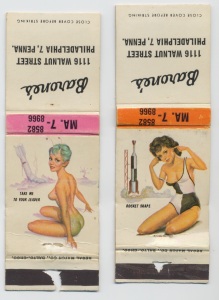Oxwood Inn
 |
| Oxford Inn |
Location: Oxnard Avenue, Van Nuys, California
Opened: 1972
Closed: 2017
Notice that this became a "queer catch-all bar" in its later years, so wasn't technically a lesbian bar at all any more. But even with that, it was the last lesbian bar in Los Angeles, even for all its "inclusivity." Which just goes to show that "inclusivity" as a drinking hole survival strategy doesn't work.
And notice that no one identified as lesbian is interviewed in this article.
From Los Angeles Magazine:
After 45 Years, L.A.’s Last Lesbian Bar Is Gone for Good
The Oxwood Inn shut its doors last weekend
The Oxwood Inn is missing its “O.” It’s hard to say how long it’s been gone, but no one bothered to replace it. The bar itself, a windowless dive sitting across from a Subway on a quiet stretch of Oxnard Avenue in Van Nuys, hasn’t had a facelift since it was purchased in 1972. Bought by Texas-born Betty “Tuck” Sutherland, it was the longest-running lesbian bar in the United States, as well as one of the only places transgender women could feel safe and welcome—until last weekend, when it closed its doors for good.
Dubbed “Menopause Manor” for its demographic—middle-aged women, many of who lived in the Valley—the Oxwood was Cheers for the lesbian working class. Two electronic darts games greeted visitors upon arrival, and a sparsely populated case offering “Bro Dart Accessories” was on the wall, looking like it hadn’t been opened since the 1980s. The place was a time warp—rarely was anyone preoccupied by their phones (at least not for noticeable lengths of time), and the old school décor included a framed portrait of Marlene Dietrich and a large art deco mirror hung on faux bois white walls. In short, it was a far cry from the purposefully decorated, dimly lit dive bars you’ll find in Los Feliz.
As products of a century where being homosexual has been both illegal and celebrated, the Oxwood’s early, original clientele saw the bar as a gathering place more than an opportunity to get drunk or meet a new potential partner. (Those were just an added bonus.) When Sutherland died in 2012, friends and family celebrated her legacy; since then, the bar had remained opened daily from 3 p.m. to 2 a.m., hosting karaoke on Thursdays, DJs on Fridays, and the trans-focused Club Shine on Saturdays. Sutherland’s former partner and longtime manager, Lynn Stadler, took over the lease after Sutherland’s death and kept its doors open despite the business costing her more than it was making her. As of last week, that cost was too high: In January of next year, the bar will be torn down and an apartment complex will going up in its place. But Stadler isn’t sad to see it go. “When something’s costing you that much money, you’re not nostalgic,” she says. “I’m glad. I’m putting over $400 a week of my own money into it, and all I have coming in is my social security.”
Stadler’s stance seems to be unique, as Oxwood regulars are already feeling the loss. “It was a different breed,” former Oxwood bartender Marianne Basford says. “It was more like a sanctuary. It wasn’t some kind of hip bar scene. It was more like a secret clubhouse for women.”
What once began as a lesbian bar turned into a queer catch-all—the opposite of the swanky, trendy clubs of WeHo with bathroom attendants and celebrity guests. And now that Club Shine is no more, transgender patrons are feeling particularly affected (though rumor has it the club night will be relocating in the future). The event was “a little bit hit-or-miss” at first, according to Laura Espinoza-Lunden, a trans promoter and musician, but it eventually grew into a full-blown movement. By the end of the first year, “it took off,” she says. “It became a home for the community.” In the end, Club Shine is what kept the Oxwood afloat for the last decade. “We would have been bankrupt long before,” Stadler says.
Zackary Drucker, a trans woman and consulting producer on Transparent, feels the Oxwood was unique in that it “created a space for queer trans women without the pressures of men entering the space as potential partners,” as she puts it. “It was the friendliest, most inclusive environment for trans women. I’m getting emotional thinking about it. The fact that there were queer cisgender woman in that space with cisgender women, queer butch women—there was such a range of people who felt comfortable there that it was truly the most inclusive trans nightlife space.”
“They’ve been wonderful to the LGBT community,” Espinoza-Lunden adds. “One of the most welcoming bars ever in L.A.”
In the Oxwood’s final week, groups gathered together on different nights to pay homage to Sutherland and the environment she helped create. “The Oxwood, which was the butt of so many jokes around the Valley, outlasted all the other bars,” Basford says. “[It’s the] end of an era.”





 Barone's Variety Room
Barone's Variety Room